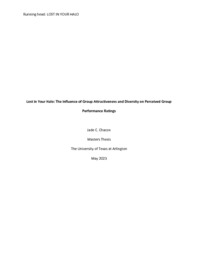
ATTENTION: The works hosted here are being migrated to a new repository that will consolidate resources, improve discoverability, and better show UTA's research impact on the global community. We will update authors as the migration progresses. Please see MavMatrix for more information.
Show simple item record
| dc.contributor.advisor | Kenworthy, Jared B. | |
| dc.creator | Chacon, Jade C. | |
| dc.date.accessioned | 2023-06-14T17:06:28Z | |
| dc.date.available | 2023-06-14T17:06:28Z | |
| dc.date.created | 2023-05 | |
| dc.date.issued | 2023-05-11 | |
| dc.date.submitted | May 2023 | |
| dc.identifier.uri | http://hdl.handle.net/10106/31247 | |
| dc.description.abstract | Research on attractiveness suggests that more attractive individuals are assumed to have superiority on several traits, such as happiness and extraversion. This is termed the halo effect. Additionally, within the diversity literature, although inconsistent, there is evidence supporting the importance of diversity within a team to promote better group performance and to foster creativity and innovation. This study examined, for the first time, whether the physical attractiveness halo effect applies to groups. Particularly, overall group attractiveness, group diversity, and their interactive influence on perceived group creative performance were examined. This experiment manipulated both the attractiveness and the diversity of the groups to be rated, and although the attractiveness hypotheses were not supported, findings suggest those with negative attitudes toward diverse groups perceive homogenous groups to work better together, be more cohesive, and cooperative when compared to diverse groups. | |
| dc.format.mimetype | application/pdf | |
| dc.language.iso | en_US | |
| dc.subject | Attractiveness | |
| dc.subject | Group performance | |
| dc.subject | Halo effect | |
| dc.subject | Diversity | |
| dc.title | Lost in Your Halo: The Influence of Group Attractiveness and Diversity on Perceived Group Performance Ratings | |
| dc.type | Thesis | |
| dc.date.updated | 2023-06-14T17:06:28Z | |
| thesis.degree.department | Psychology | |
| thesis.degree.grantor | The University of Texas at Arlington | |
| thesis.degree.level | Masters | |
| thesis.degree.name | Master of Science in Psychology | |
| dc.type.material | text | |
Files in this item
- Name:
- CHACON-THESIS-2023.pdf
- Size:
- 10.10Mb
- Format:
- PDF
This item appears in the following Collection(s)
Show simple item record


